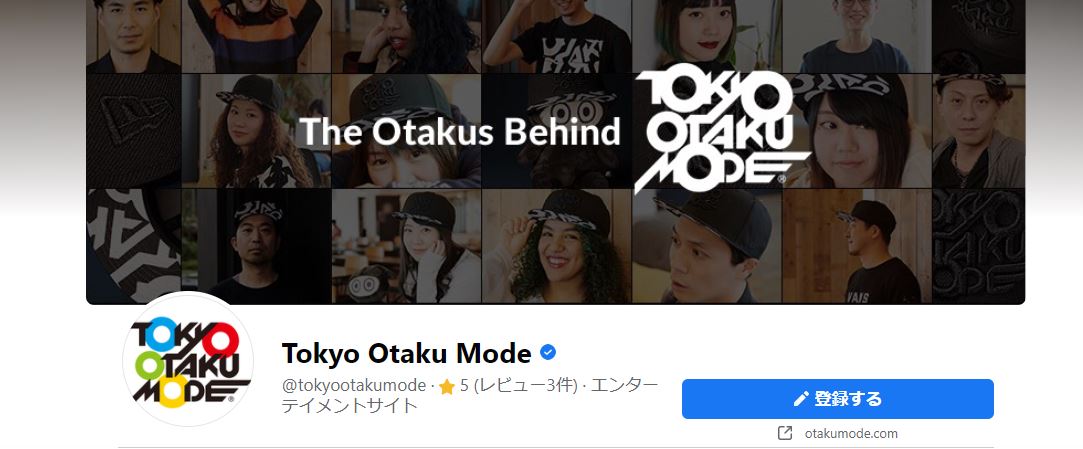All About OTAKU: Tokyo Otaku Mode
CONTENTS
What is Otaku Mode?
Conquering the World with Otaku Power
Facebook is one of the most popular SNSs in Japan, as it is in many other countries. Anyone can have their own account and share info with their friends and others. Companies can set up their own page and send out their newly developed products and service info globally. Any organization, big or small, can use those pages as a bulletin board to keep their members informed. It has set down deep roots in Japan and is part of many people’s daily routine.
Amidst this Facebook momentum, one page has been attracting quite a bit of attention these days. Tokyo Otaku Mode sends out English-language news concerning aspects of the so-called otaku[1] world, such as Japanese manga, anime, cosplay, or games. This page amassed more than 20 million fans over a very short time --- a record number for a Facebook page developed by Japanese.

Abbreviated TOM, the page was set up two years ago just after the 3.11 catastrophe. Soon after the launch, its popularity caught fire. Within just four months it collected 1 million fans; a year later, 5 million, and just this past January, it had reached the milestone of 10 million. And it is still growing steadily at around 13,000 fans per day. “There should be more otaku fans in the world. My hunch is 50 million,” grins Tomo Kamei, CEO and co-founder of Tokyo Otaku Mode Inc.
Just a brief glance will demonstrate that the purpose of Kamei’s page is to introduce Japanese otaku contents: newly-released popular anime characters’ products, reports on a cosplay event, comic markets, articles on the town of Akihabara, the Mecca for otaku fans, and so on. Many of the news items are originally produced by TOM. You can find up-to-date pieces of news on otaku industry. Although most of the contents originates in Japan, much of the feedback and comments on news items come from abroad, from countries in North and South America, Europe, Southeast Asia, and so on. In fact, more than 99% of its fans are non-Japanese. Japanese are believed to account for a mere 0.5% out of the 11 million regular followers (as of April 5).
It is hard for investors to ignore such a high potential medium. Last April, 500 Startups, a well-known seed accelerator or Venture Capital firm based in Silicon Valley decided to invest in TOM. Merely to be chosen is something of an honor in itself and that gained a lot of attention.
Some business magnates, famous in Japan’s IT industry, have already invested in TOM as individuals. One of them is Joi Ito, director of the MIT (Massachusetts Institute of Technology) Media Lab, who has also come on board as an advisor. Mr. Ito also works as an outside director at The New York Times.
Not an Otaku Fan but Entrepreneur
It would be no surprise if TOM’s founder Kamei were an otaku himself. But he neither confirms nor denies it.
“I’m not a dyed-in-the-wool otaku,” he says. “I like manga and play video games sometimes, but I started this company not because I like anime or manga so much, but because I was purely interested in starting up my own business.” Kamei had been a full-time employee with Cyber Communications Inc. (CCI), a major Internet advertising agency, until a year ago. The page was set up a year earlier, but his own company itself was founded on April 10, 2012, just after he resigned from CCI. Ten years since he entered into the workforce, Kamei immersed himself in the IT industry.
[1] A term used generally to describe someone with obsessive interests, an in particular people who commonly focus on video games, magna comics or anime films.
“I was often transferred to affiliated companies where I felt the dynamism of the Internet industry, and felt attracted to the challenge to do something new,” he explains.
During his loan to those companies, he built up his human network and began to feel like setting up his own company.
“Then, I wondered what would be a plausible business?” Kamei asked himself. When he was with CCI, Facebook’s profile in Japan was still low, but it was already in use by five million people abroad. One of his roles was to facilitate Japanese companies to set up their page on it.
“I came up with the idea of opening my own and sending information on Japan’s contents worldwide,” he says.
Many kinds of Japan-related contents exist. But Kamei paid particular attention to otaku culture.
“I talked to my foreign friends in the US, Russia or Asian countries, and most of them were familiar with popular titles of Japan’s anime, manga or video games. But they all complained that the info was only available in Japanese.” True, many personal blogs can be found in foreign languages, but their info was neither timely nor trustworthy. This convinced Kamei to create a Facebook page, Tokyo Otaku Mode, as an English-language medium on Japan’s subculture.
But perhaps otaku should no longer be referred to as subculture. When TOM was featured on Facebook Stories, a Facebook official site this past January, editor-in-chief Dan Fletcher commented, “Otaku, once a term of derision inside Japan for a person deemed to be socially inept, isn’t something to be ashamed of anymore. Instead, it’s a badge worn proudly by the nearly 10 million people who follow the Tokyo Otaku Mode Page on Facebook, all of whom share an interest in keeping up with the latest of Japan’s prodigious cultural output.”
Challenge upon Challenge
The road to the 10 million milestone, however, had some bumps. First, the catastrophic earthquake and tsunami on March 11, 2011 postponed the planned inauguration and for the first month visitors to the new page were very few.
“We set a target to attract 100,000 fans within the first six months, but the number reached less than 1,000 in one month,” Kamei recalls. He and his staff were in a quandary as to whether they should drop that goal, but they persisted.
One month after 3.11, Japan was still struggling to shed the mood of gloom that pervaded. The image of the disaster and aftermath were known throughout the world. But TOM’s staff believed that sending out Japan-related contents would help make the world aware of the country’s joyful side and give Japan a more favorable image.

They continuously uploaded news about otaku, such as a story about newly-opened shop in the Akihabara district, or an event featuring some popular animation. The stock of their articles continued to pile up, which worked to attract attention. After two months, thanks to links to some popular pages, the number of fans had increased by 10,000 per day sometimes. Fans brought in other fans, and the process snowballed. This dissemination by word of mouth can be highly effective as long as a site’s contents are good.
But Kamei and his team faced new challenges. Now they write and upload around 10 articles every day. Scouting out new releases and information and posting them to the page is no easy task. It entails hitting the streets, researching, interviewing, taking photos, and writing. Including Kamei, the team currently has only four full timers, so they are assisted by a group of about 50 to 60 volunteers who are eager to help promote the spread of otaku culture abroad.
“Many of them come to our office on weekends and others do some work on weekdays via email,” says Kamei. Some of the articles are written directly in English, but most of them are initially written in Japanese, which require translation, by another group of volunteers outside Japan who help with translations.
“They are all conscientious people who find it worthwhile to devote their time to it. But managing those people and a team of Japanese and non-Japanese editors is not easy,” Kamei points out.
The mentors of 500 Startups have also provided various advice. This fund has a three-month program in which selected companies can refine their business model, its service, or user-interface with assistance from those mentors.
“We were told to attract good fans,” says Kamei. “They spread the word and help us build a good brand image. To collect those good fans, they told us to focus on good user-interface and user-experience.”
In a nutshell, design is extremely important. Kamei was advised to shed unnecessary elements to the greatest degree possible.
“Minimizing the numbers of mouse clicks for example --- we were told to simplify the user interface and think of the best design. That’s what they call design,” says Kamei with an emphasis. Dave McClure, co-founder of 500 Startups, advised him to focus on good contents and design, but not expect a quick return on investments.
The Stage of Monetization

As a business, TOM has got to make a profit. Right now, it obtains funding mainly through on-line advertisements. Tokyo Otaku Mode, Inc. thinks Facebook is a good tool to gather fans, but not for generating revenues. So they try to link fans to their newly built stand-alone website (www.otakumode.com) for fans and opinion leaders to share and discuss their own creations and then introduce related commodities for sale.
Also in order to appeal to light otaku fans, they developed a new iOS and Android app named Otaku Camera, which allows fans to apply popular magna or animation background to photos they take on their mobile phones. This free app has climbed to the top spot in some countries and the number of downloads has reached already well over two million since December, 2012.
At the moment, Japan’s otaku contents have yet to attract a large customer base abroad. According to the Ministry of Economy, Trade and Industry, Japan’s contents industry like movies, anime, TV programs, games and books is 12 trillion yen ($133 billion) in size, second worldwide after the United States. But only 5% of revenues comes from overseas, as opposed to 17.8% in the case of the US. TOM may eventually play a significant role in appealing to prospective customers overseas. They are beginning to build a symbiotic relationship with the publishing houses and contents’ holders.
Kamei’s aim is to sell those contents abroad and return the profits they earn to the contents holders.
“Japan’s domestic market is diminishing due to the low birthrate, and piracy is rampant abroad,” he says. “To tackle those problems and for the industry’s longevity, it is very important to cultivate overseas markets. “When I talk with contents holders such as publishers or production companies, some tend to give me a condescending look just because I am a novice in their market,” he remarks, adding, “But I want to gain their understanding by giving them good results.”


